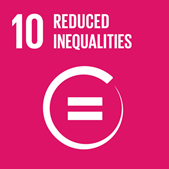Sustainable Development Goals (SDGs) – SDG10 – Engineers contribute to ‘Reduce inequality within and among countries’
By Eng. (Dr.) Saja A. A. Majeed
 Inequality can arise not only on an income or economic basis but also it is entwined with inequality in opportunities and access to services, such as in health, housing, food and education sectors. This means that SDG 10 is very much linked to many other SDGs. For example, SDG 1 - elimination of poverty is the foremost target to end wider inequality in the society. Similarly, SDG 8 - Decent work for all is vital in addressing the inequality in income and opportunities. Mark Malloch-Brown, United Nations Deputy Secretary General clearly articulated the role of engineers and entrepreneurs, not tax collectors, who contribute to reducing inequality by means of building inclusive, productive economies on a platform of sustainable energy and infrastructure.
Inequality can arise not only on an income or economic basis but also it is entwined with inequality in opportunities and access to services, such as in health, housing, food and education sectors. This means that SDG 10 is very much linked to many other SDGs. For example, SDG 1 - elimination of poverty is the foremost target to end wider inequality in the society. Similarly, SDG 8 - Decent work for all is vital in addressing the inequality in income and opportunities. Mark Malloch-Brown, United Nations Deputy Secretary General clearly articulated the role of engineers and entrepreneurs, not tax collectors, who contribute to reducing inequality by means of building inclusive, productive economies on a platform of sustainable energy and infrastructure.
The work of engineers and engineering play a key role in reducing inequality through the development of infrastructure facilities and innovative new technologies, which ultimately create many job opportunities and skilled workforce (These activities are linked to SDG8:Decent Work and Economic Growth and SDG9: Industry, Innovation, and Infrastructure) (UNESCO 2021). There are 1.8 billion young people in the world and they need to be given appropriate opportunities to join the global work force and contribute to the economic growth. Further, women representation is 28% of the workforce in Science, Technology, Engineering and Math (STEM), hence more equal opportunities need to be created to ensure gender equality (AAUW) - we have SDG 5 which is solely focusing on reducing gender inequality.
Inequality exists in technology development and its benefits which are based on the affordability of access to those new technologies. Further, inequality is widely prevalent in many other sectors, for example, in the form of technology injustice such as access to clean and affordable energy which are key to access other basic services: to enable hospitals to operate equipment, to power irrigation systems to produce food, and to light houses so that children can achieve a basic level of education (RAE 2016). In this context, how can Engineers contribute to attain Sustainable Development Goal (SDG) 10 – ‘Reduce inequality within and among countries’, which is to reduce income inequality in our societies and give a greater focus to the needs of disadvantaged and marginalized people.
Global key figures related to ‘Reduce inequality within and among countries’ (SDG10)
Some of the relevant global key figures related to ‘Reduce inequality within and among countries’ provided in the United Nation statistics include (https://sdgs.un.org/goals/goal10):
- The GINI index fell for 38 out of 87 countries, which measures the extent to which the distribution of income (or, in some cases, consumption expenditure) among individuals or households within an economy deviates from a perfectly equal distribution
- Resource flow in development for developing countries has reduced from US$420 billion (2017) to US$271 billion (2018)
- The COVID-19 crisis is hitting the poorest and most vulnerable people the hardest
- In 31 countries over the period between 2014–2019, one in five persons reported having personally experienced discrimination on at least one ground of discrimination prohibited by international human rights law
SDG 10 (Reduce inequality within and among countries) targets
SDG 10 sets out seven key targets and three additional targets (10.a, 10.b, and 10.c) for resource mobilisation and policy to be achieved by 2030. The ten key targets are:
10.1. By 2030, progressively achieve and sustain income growth of the bottom 40% of the population at a rate higher than the national average
10.2. By 2030, empower and promote the social, economic and political inclusion of all, irrespective of age, sex, disability, race, ethnicity, origin, religion or economic or other status
10.3. Ensure equal opportunity and reduce inequalities of outcome, including by eliminating discriminatory laws, policies and practices and promoting appropriate legislation, policies and action in this regard
10.4. Adopt policies, especially fiscal, wage and social protection policies, and progressively achieve greater equality
10.5. Improve the regulation and monitoring of global financial markets and institutions and strengthen the implementation of such regulations
10.6. Ensure enhanced representation and voice for developing countries in decision-making in global international economic and financial institutions in order to deliver more effective, credible, accountable and legitimate institutions
10.7. Facilitate orderly, safe, regular and responsible migration and mobility of people, including through the implementation of planned and well-managed migration policies
10.a. Implement the principle of special and differential treatment for developing countries, in particular least developed countries, in accordance with World Trade Organization agreements
10.b. Encourage official development assistance and financial flows, including foreign direct investment, to States where the need is greatest, in particular least developed countries, African countries, small island developing States and landlocked developing countries, in accordance with their national plans and programmes
10.c. By 2030, reduce to less than 3% the transaction costs of migrant remittances and eliminate remittance corridors with costs higher than 5%

SDG 10 (Reduce inequality within and among countries) target indicators (examples)
The achievement of ‘reduce inequality within and among countries’ goal is measured by the following set of key indicators:
- Growth rates of household expenditure or income per capita among the bottom 40% of the population and the total population
- Proportion of people living below 50% of median income, by age, sex and persons with disabilities
- Proportion of the population reporting having personally felt discriminated against or harassed within the previous 12 months on the basis of a ground of discrimination prohibited under international human rights law
- Labour share of GDP, comprising wages and social protection transfers
- Recruitment cost borne by employee as a proportion of yearly income earned in country of destination
- Number of countries that have implemented well-managed migration policies
Detail indicator descriptions are available at https://unstats.un.org/sdgs website
Current status of SDG 10 progression in Sri Lanka
The current status of achieving SDG 10 in Sri Lanka was reported in the recent review by the Government of Sri Lanka (SLVNR 2018). Some of the key contributions include:
- The household income per capita of the bottom 40% has grown faster at 26% during 2012/13 – 2016, compared to the 18% of the national average
- Migrant remittances account for 8.9% of GDP; almost one in every eight households is a remittance recipient. A minimum wage for migrant workers was established at USD 300 by the GoSL in 2017. Around 2.5 percent of Sri Lankan migrant workers are professionals including Engineers (SLBFE)
- Securing preferential access to foreign markets, Sri Lanka has the benefits of the Generalised System of Preferences (GSP) facilities offered by several countries including the United States of America (USA) and the European Union (EU)
GINI index (World Bank estimate) in Sri Lanka was reported at 39.3 (2016) and 51.4 (2018) [Gini index of 0 represents perfect equality, while an index of 100 implies perfect inequality].
Role of engineering to advance SDG 10 - ‘Reduce inequality within and among countries’ and examples
Some selected examples from world reputed engineering organizations are provided below briefly:
- By 2025, the world will have exceeded 50% urbanisation and for Africa, doubling of the population has become an imperative. However, there is little sign of jobs and infrastructure keeping up with this prospective demand. The population growth of cities in South Asia has huge implications for social and human costs when housing, sanitation and clean water, and transportation systems are exhausted and unable to cater the increasing demand effectively (RAE 2018)
- Students of civil engineering in Mexico implemented infrastructure projects to mitigate the levels of marginalization and inequality in the communities and provide housing and basic services and better education, raise awareness among young people and government authorities of social and environmental problems and develop solutions to community problems (WFEO 2018)
- Low cost fridge called ‘Chotukool’ (US$69) developed in India helps to keep the food cooler, enables women to engage in more economic activities (WIPO 2013; UNESCO 2021)
- In Africa, a mobile based money transfer system called ‘M-Pesa’ which enables mobile payment systems and financial transactions without a bank account (www.safaricom.co.ke ; UNESCO 2021)
Next SDG: SDG 11 - Sustainable cities and communities
In the next issue of digital SLEN, we will continue with the snapshot of SDG 11: “Sustainable cities and communities‘’. All SDGs are well connected, and thus require a holistic view to address real development challenges. Until then, let us reflect on SDG 10 – ‘Reduce Inequalities’ and its central role in the Engineering sector and profession. Your comments on how we as Engineers can contribute to achieve SDGs can be posted in the IESL Facebook page https://www.facebook.com/IESLSriLanka/.
References
- https://unstats.un.org/sdgs/indicators/Global%20Indicator%20Framework%20after%202019%20refinement_Eng.pdf
- https://www.wfeo.org/wp-content/uploads/stc-young_engineers/WYEC-BROCHURE_FINAL_VERSION.pdf
- Royal Academy of Engineering, 2016. Achieving the United Nations Sustainable Development Goals, Engineering a better world, https://www.raeng.org.uk/publications/other/engineering-a-better-world-brochure
- Sri Lanka Voluntary National Review (SLVNR) on the Status of Implementing Sustainable Development Goals, 2018. Ministry of Sustainable Development, Wildlife and Regional Development, Published by the Ministry of Sustainable Development, Wildlife and Regional Development in June, 2018.
- WFEO (2018) The Paris Declaration: Advancing the UN Sustainable Development Goals through Engineering, 7 March 2018, WFEO and UNESCO Declaration, available in Annex 1 at the https://sustainabledevelopment.un.org/content/documents/241538_World_Federation_of_Engineering_Report.pdf (Accessed on 11 November 2020).
- Engineers Without Borders, https://www.ewb.ca/en/hello2030/affordable-and-clean-energy/ and https://www.ewb.org.au/solarenergyproject/ ,
- UNESCO (2021) United Nations Educational, Scientific and Cultural Organization, Engineering for Sustainable Development - Delivering on the Sustainable Development Goals, March 2021, https://unesdoc.unesco.org/ark:/48223/pf0000375644/PDF/375644eng.pdf.multi
- https://www.aauw.org/resources/research/the-stem-gap/
- Sri Lanka Bureau of Foreign Employment (2015), https://www.ilo.org/wcmsp5/groups/public/---asia/---ro-bangkok/---ilo-colombo/documents/publication/wcms_568718.pdf
- Chotukool: Keeping things cool with frugal innovation, WIPO Magazine 2013, https://www.wipo.int/wipo_magazine/en/2013/06/article_0003.html
 Eng. Saja A.A. Majeed
Eng. Saja A.A. Majeed
BscEng, MScEng, PhD
Lecturer
Faculty of Engineering
South Eastern University of Sri Lanka





